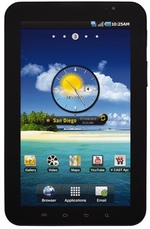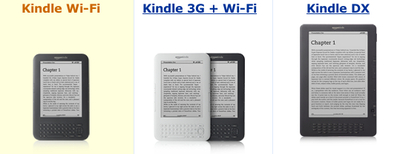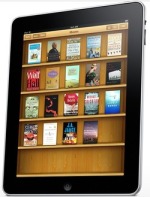iPad vs. Kindle, tablets and plain old books
 Saturday, November 6, 2010 at 3:13 PM
Saturday, November 6, 2010 at 3:13 PM I've resisted writing a Kindle vs. IPad post because too many others have done it already, and done it better. But after several comments from friends and co-workers who say they want advice from someone they know, I decided to bang something out. And since I use this site as a testbed, I’ll conduct an experiment at the same time and see what kinds of ads Google delivers to the left of this post.
This advice assumes you're interested in paying the money for a dedicated e-reader. If not, you'll want to stick to physical books or download a Kindle app to your smartphone or desktop. The Kindle apps aren't ideal options for extended reading, but they do in a pinch. And they're free.
OK, now to the e-reader question:
In short, if you're a voracious reader of books but only a casual reader of anything else, go with the Kindle or the new Barnes & Noble Nook. If you're a reader of all things, like to read in the dark and for shorter periods, and want to buy something now, check out the iPad. If you can wait and don't like Apple's all-or-nothing approach to content, you might want to wait for the wave of Android-powered tablets just arriving in the  The Samsung Galaxy tablet is powered by Androidstates. The Samsung Galaxy tablet will be available from Best Buy, Verizon and Sprint in early November for $400-$600. It’s smaller than the iPad (7 inches vs. 10 inches) so will be lighter. There’s even a $150 Android reader for sale at Kmart; it may not be the perfect solution but is indicative that open-source tablets will cost much less than iPads as time goes on.
The Samsung Galaxy tablet is powered by Androidstates. The Samsung Galaxy tablet will be available from Best Buy, Verizon and Sprint in early November for $400-$600. It’s smaller than the iPad (7 inches vs. 10 inches) so will be lighter. There’s even a $150 Android reader for sale at Kmart; it may not be the perfect solution but is indicative that open-source tablets will cost much less than iPads as time goes on.
I highly encourage going to Best Buy, Target and other stores to physically test all the devices. These things are pricey so you don't want to buy blind.
I think e-readers make reading more fun, but if you’re short on cash, have very eclectic taste or enjoy hanging out in libraries, you may want to stick to physical books.
A little bit of detail on a few platforms:
 Amazon offers three versions of its KindleAmazon Kindle: I've had a Kindle 2 for a while and love it.
Amazon offers three versions of its KindleAmazon Kindle: I've had a Kindle 2 for a while and love it.
- Strengths: integrated free wireless cell connection to the Kindle store and the web; fantastic library of books, newspapers, magazines and blogs, many at relatively low prices; ability to sample books, long battery life, nice screen contrast that's easy on the eyes (including outdoors), relatively light weight, apps for smart phones that sync the furthest point read; full content from the Sunday New York Times for 75 cents; and the Kindle blog, which highlights good reads and often gives access to free downloads. Amazon has lowered pricing for its new Kindles: $139 or $189 for its 6-inch models and $379 for the 10-inch DX.
- Weaknesses: no back lighting; restricted to Kindle store, although you can import ebooks and other docs; poor web-browsing experience.
 Apple features a growing e-bookstoreApple iPad: I've had an iPad since August and continue to be wowed by its features. It is much more than an e-reader so comparisons are skewed.
Apple features a growing e-bookstoreApple iPad: I've had an iPad since August and continue to be wowed by its features. It is much more than an e-reader so comparisons are skewed.
- Strengths: Jaw-dropping visual experience with brilliant full-color display and intuitive controls; integration with your existing iTunes/iPod libraries; fantastic browsing experience; excellent virtual keyboards; ability to view video books; excellent iWorks apps to do work outside the office; growing app store; relatively limited bookstore but growing non-book content offerings like magazines and newspapers. It's a full-blown computer so the differences with the Kindle are dramatic (not necessarily a good thing, depending on your habits). If you're not a movie junkie, the 16-gigabyte version will probably be enough but if you have the money, I'd go to 32-gig just for flexibility.
- Weaknesses: The iPad is thin and beautiful but relatively heavy when compared to the Kindle2. It is not comfortable reading for extended periods in bed, for example. The glossy backlit screen can be hard on the eyes after a while. It's very hard to read outdoors. The iPad comes in wi-fi with the option to add 3G access for a month-to-month fee. The 3G access from AT&T costs $15-$30 per month depending upon data usage. That $15 can go quickly if you're not careful in tapping wi-fi where possible.
 Borders offers a bunch of e-reader optionsRegarding other popular e-readers, I have not used the Sony Reader, Barnes & Noble Nook and others offered through Borders other than testing them in the stores, so I can't comment from true long-term experience. But based on my quick tests and what I've read from respected critics, Kindle is still the dedicated e-reader to beat.
Borders offers a bunch of e-reader optionsRegarding other popular e-readers, I have not used the Sony Reader, Barnes & Noble Nook and others offered through Borders other than testing them in the stores, so I can't comment from true long-term experience. But based on my quick tests and what I've read from respected critics, Kindle is still the dedicated e-reader to beat.
And as I’ve said before, a wave of Android-powered readers will be hitting the U.S. soon, with the Samsung Galaxy and the Cruz Tablet among the first to hit market. Features will improve, prices will fall and consumers will win.
 Android,
Android,  Cruz Tablet,
Cruz Tablet,  Kindle,
Kindle,  Samsung Galaxy,
Samsung Galaxy,  e-books,
e-books,  iPad,
iPad,  tablet
tablet  Books,
Books,  Technology
Technology 
Reader Comments (2)
You didn't mention you can share books you buy on the Nook. That's a big thing in my BOOK!
Good point.
In fact, Amazon a few weeks ago recognized that could be a big advantage for B&N among hardcore readers and announced it would offer a similar feature later this year.
The fine print in Amazon's deal is you can share a book once, for 14 days. The B&N restrictions are similar.